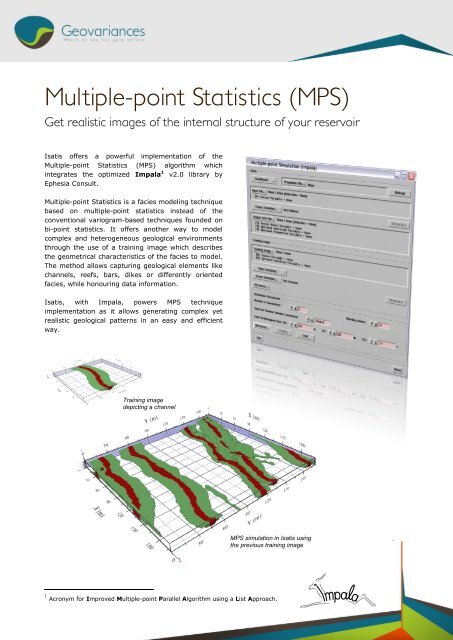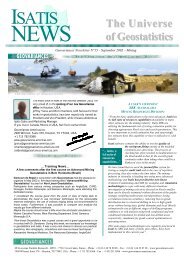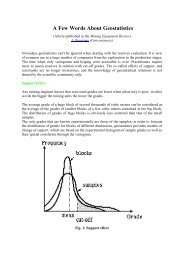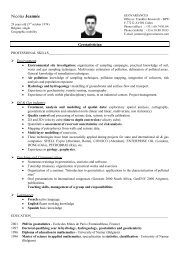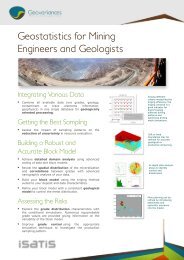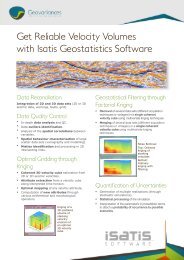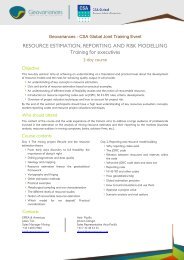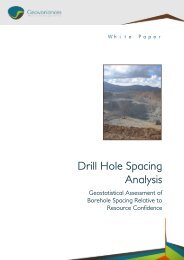Isatis Multiple-point Statistics (MPS) - Geovariances
Isatis Multiple-point Statistics (MPS) - Geovariances
Isatis Multiple-point Statistics (MPS) - Geovariances
You also want an ePaper? Increase the reach of your titles
YUMPU automatically turns print PDFs into web optimized ePapers that Google loves.
<strong>Multiple</strong>-<strong>point</strong> <strong>Statistics</strong> (<strong>MPS</strong>)<br />
Get realistic images of the internal structure of your reservoir<br />
<strong>Isatis</strong> offers a powerful implementation of the<br />
<strong>Multiple</strong>-<strong>point</strong> <strong>Statistics</strong> (<strong>MPS</strong>) algorithm which<br />
integrates the optimized Impala 1 v2.0 library by<br />
Ephesia Consult.<br />
<strong>Multiple</strong>-<strong>point</strong> <strong>Statistics</strong> is a facies modeling technique<br />
based on multiple-<strong>point</strong> statistics instead of the<br />
conventional variogram-based techniques founded on<br />
bi-<strong>point</strong> statistics. It offers another way to model<br />
complex and heterogeneous geological environments<br />
through the use of a training image which describes<br />
the geometrical characteristics of the facies to model.<br />
The method allows capturing geological elements like<br />
channels, reefs, bars, dikes or differently oriented<br />
facies, while honouring data information.<br />
<strong>Isatis</strong>, with Impala, powers <strong>MPS</strong> technique<br />
implementation as it allows generating complex yet<br />
realistic geological patterns in an easy and efficient<br />
way.<br />
Training image<br />
depicting a channel<br />
<strong>MPS</strong> simulation in <strong>Isatis</strong> using<br />
the previous training image<br />
1 Acronym for Improved <strong>Multiple</strong>-<strong>point</strong> Parallel Algorithm using a List Approach.
Impala algorithm has been optimized in many ways:<br />
It offers a new and efficient strategy for recording<br />
matching configuration. Multi-<strong>point</strong> statistics are stored<br />
in hybrid tree-list structures rather than search trees,<br />
thus resulting in a substantial reduction in memory<br />
requirements and in a higher calculation speed.<br />
Being fully parallelized, it benefits from multiprocessors,<br />
which also drastically improves the<br />
calculation performances.<br />
It uses a multi-grid approach to capture structures<br />
within the training image that are defined at different<br />
scales, which avoids considering a huge pattern.<br />
Unlike classical <strong>MPS</strong> algorithms which tend to<br />
reproduce the global proportions of the training image,<br />
<strong>Isatis</strong> Impala-based <strong>MPS</strong> uses soft local proportions to<br />
simulate non stationary environment.<br />
It may take into account external continuous<br />
conditioning data which can be diagraphy, seismic or<br />
well information, but also a gradient (i.e. distance to<br />
the coast, distance to specific topographic object, etc.).<br />
This allows refining and enhancing the realistic aspect<br />
of the simulations and enables the simulation of non<br />
stationary deposit environment.<br />
Besides, <strong>Isatis</strong> provides functionalities to create 2D<br />
training images from imported images and considers<br />
object-based or plurigaussian non conditional simulations<br />
as potential 3D training images.<br />
<strong>Isatis</strong> <strong>MPS</strong> Key Points<br />
High performances<br />
Parallel algorithm (CPU performances)<br />
Based on lists (RAM performances) and<br />
trees (speed performances)<br />
Unique features<br />
Multi-grid approach for capturing efficiently<br />
large scale features<br />
Conditioning to hard data (seismic, facies<br />
proportions)<br />
Non–stationarity handled with continuous<br />
auxiliary variables or local proportions<br />
Advantages<br />
Intuitive use of training images (seismic,<br />
geological model, analogs, boolean<br />
simulations)<br />
Full control of parameters<br />
Proper modeling of non stationarity and local<br />
proportions<br />
More flexibility on search template size and<br />
number of facies<br />
Improved efficiency<br />
This Impala-based <strong>MPS</strong> algorithm complements <strong>Isatis</strong><br />
Plurigaussian Simulations (PGS) already used to<br />
model complex geology geometries. It enriches the<br />
exclusive range of facies modeling techniques <strong>Isatis</strong><br />
already offers (including object based simulations like<br />
Boolean, Dead Leaves or Dilution techniques, variogrambased<br />
simulations like SIS, TGS, PGS or training imagebased<br />
simulations like the Annealing Simulations).<br />
Simulation of dykes<br />
with <strong>Isatis</strong> new <strong>MPS</strong><br />
GEOVARIANCES offices<br />
France - Avon-Fontainebleau - +33 (0)1 6074 9090<br />
Australia - Wynnum-Brisbane, QLD - +61 (0)7 3348 5333<br />
info@geovariances.com - www.geovariances.com


